I’m sitting in a kayak at the Sammamish River mouth on Lake Washington. Three hundred or so Common Mergansers flock nearby─in the slough fishing, roosting on the lake or flying in-between. The heavy birds fly at 40 mph up and down the tree-lined slough, a gauntlet that challenges the electronic viewfinder (EVF) and auto-focus of my Sony A7 III. I pre-focus at a close distance; I don’t want a bird small in frame. When a bird flies by, I desperately pan as I depress the shutter. If I stay on the bird, I get hits with sharp eyes. The focus tracking works. Remarkably, even when I lose the bird, I sometimes get a sharp shot or two. Most often my panning fails to match the accelerating fly-by and my pics end up soft (not necessarily OOF), but that’s operator error. I have confidence that the A7 III meets birds-in-flight (BIF) demands.
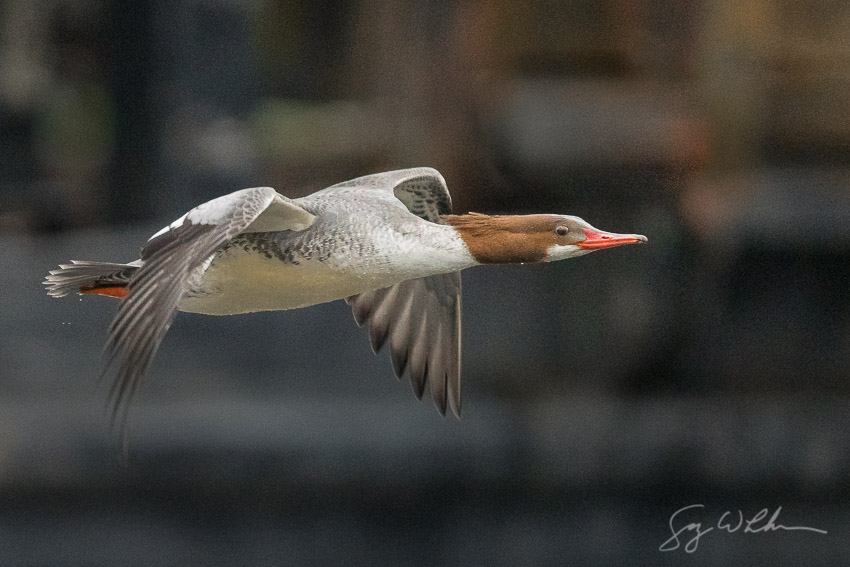
I first shot mirrorless using an electronic viewfinder (EVF) with the cropped-frame Sony a6300 three years ago. It worked well, even outstandingly well, for most photography, but not for BIF. Unlike the crisp, real-world, speed-of-light optical viewfinder (OVF) of a dSLR (digital single lens reflex), the virtual image one sees through an EVF takes time to process and display. You don’t see in real time, and with a brisk or accelerating rate of pan, I found birds impossible to track, let alone focus on. My solution then was to grab my OVF Canon 5D III and a Canon lens. I could then follow BIF in real-time, a huge advantage. But the 5D focus tracking often failed, either by jumping to the background (ok, this was perhaps operator error), or by focusing on the birds feet, not the eye (from auto-focus not up to the task), as it whizzed pass. The 5D III, with its not-quite-professional 2012 tech, couldn’t produce.

With the introduction of the Sony A9 that shoots 20 fps with no blackout, and then the A7 with similar auto-focus but 10 fps, mirrorless cameras have hit the holy grail of bird photography, capturing BIF. A month after purchasing the A7 III and a Sony FE 100-400mm GM f4.5-5.6 lens, I sold my Canon 5D III; I simply wasn’t going to use it anymore (Note I can’t compare my new Sony to the acclaimed Canon 5D IV on a Canon 500 f/4L II or 100-400mm f/4.5-5.6L II. I suspect it would equal or might even beat my Sony combo for BIF). In 2018, Nikon and Canon entered the full-frame mirrorless game. The future, I believe, is mirrorless.
Put bluntly, the dSLR solves a problem that no longer exists, a carryover from film. The SLR mirror, prism and OVF cleverly allowed the photographer to look through the lens to see the scene just as the lens does. Unlike film, modern sensors create a video feed that appears on the LCD or in a mirrorless camera’s EVF. No need then for the mirror, but there are differences. Instead of showing the scene as the lens sees it, software interprets what the sensor sees, adjusting for exposure, depth-of-field, white-balance, etc. Corrections can thus be made before clicking the shutter, not after review. Mirrorless has advantages, and the disadvantages are shrinking.
Mirrorless cameras are lighter in weight and smaller in size. Getting rid of the mirror positions the lens mount closer to the sensor, an aid to both lens design and shrinking the body. More important, speed (frame rate) and autofocus have the potential to improve beyond the capability of a dSLR. Limited by the flipping mirror, dSLR frame rates have peaked at 12 or 14 frames/sec. The aforementioned Sony A9 20 frames/sec sensor has no black-out or auto-focus interruption inherent with a dSLR. Focus is via a hybrid phase-detection plus contrast directly on the sensor, rather than through the mirror to a small, separate focus sensor as with dSLR’s. Focus points can be spread over the entire sensor surface, allowing huge advances as software intelligently tracks focus on a face or eye, and now even on animal eyes! A dSLR focus system can’t offer that.
Dropping to a more affordable mirrorless which I own, the Sony A7 III inherits the A9 auto-focus and its ability to stick the focus on on-coming birds. With months now in the saddle working difficult, fast-moving birds, I can say the focus stays with the bird if I do. I rarely get focus on the bird’s feet instead of the eye, when shooting with my Sony 100-400mm GM lens. Focus is also more precise. No need for lens/body calibration as in dSLR’s. For example, my ancient Canon 500mm f/4 focuses with better accuracy for portraits using my Sony’s (A7 III or crop-frame a6300) and a Metabones IV adaptor compared to my Canon 5D III. Notice I said for portraits. For moving birds or flight, my old Canon 5D III combined with a Canon lens works far better than the Sony/Canon/Metabones combo. To take full advantage of Sony auto-focus, Sony lenses may be required.

EVF’s have other advantages. An EVF allows you to see into dark underbrush. I love using the EVF to change menu settings, monitor video, review images in bright sunlight and even move the auto-focus point with a finger on the touch-sensitive LCD─with eye glued to the viewfinder throughout. No need anymore for that cumbersome loupe attached to the LCD screen. And the electronic shutter is totally silent; how many times have you clicked the shutter of a dSLR and witnessed a bird’s startled reaction. So many situations where stealth is useful.
Another plus is that EVF’s need no depth-of-field preview button (lenses designed for mirrorless generally stop down automatically with exposure remaining correct). With an OVF, stopping down with the preview button darkens the view, fading critical detail.
Mirrorless offers manual focus aids as well, such as scene magnification and sharp focus indicators (peaking). Granted dSLR may have these features, but with LCD screen only while outdoors, they can be difficult to see.
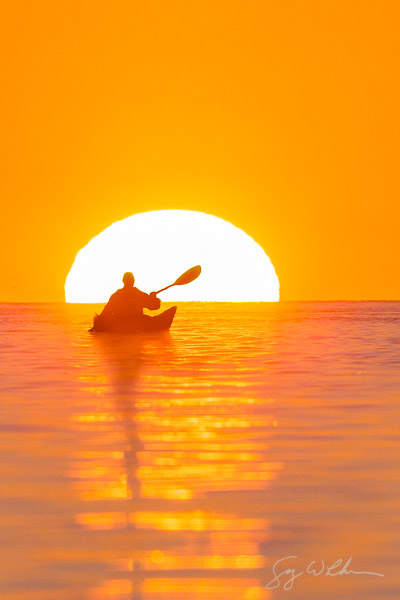
Another plus, for me anyway, I can shoot directly into a rising sun without worry of eye damage (could get sensor damage, but which is worse?). Numerous times in my career I’ve pasted gel over the eyepiece of a dSLR to frame a big sun and kayaker at sunrise or sunset. And then I never knew if the exposure was correct, so I’d bracket a lot. The EVF makes this sort of shot easier.
I like the view through the EVF, as well, because it requires no corrective glasses. It also works fine with polarized sunglasses, unlike an LCD. I will say though that seeing through the EVF can be difficult in bright, right-side-lit or backlit sunlight, where the sun strikes the eye at the same time you’re trying to get a look through the viewfinder. If this is an issue, a good eyecup can alleviate the problem.
Finally, mirrorless is generally a better choice for video. My Sony’s have very good 4K, 2K at 120 fps, and excellent format, log mode and focusing options. Very important, you see through the EVF while recording. Compare that view to a dSLR’s LCD.
Mirrorless does have some serious downsides. Firstly, battery life is less, and although I can shoot all day with the improve-battery-life A7 III, the fact that you need the EVF turned on to even see the scene is an annoyance. This especially comes to the fore when I’m scouting for landscapes. I do a lot of mid-day hiking with camera, with no intention of shooting until magic hour. I visualize, take mental notes and look through the viewfinder to see. To conserve battery, I turn the camera on and off. If I’m forced to conserve on a multi-day backpack, I may wait for sweet light entirely before engaging a viewfinder view.
One battery conservation strategy is to set the sleep function on the camera to a low setting. But then if you need to react quickly, it takes a second to awaken and an image to appear in the viewfinder, so you miss the shot.
A second issue, the expensive Sony A9 excepted, users of mirrorless experience black-out of the viewfinder with each shutter release, just like dSLR’s, caused by the shutter and/or clearing the sensor data. Mirrorless cameras often give a shooting choice of mechanical or electronic shutter. But using the electronic shutter at the highest frame rate mostly means the sensor can’t both record the scene and give you a live view, so it presents the last recorded image instead.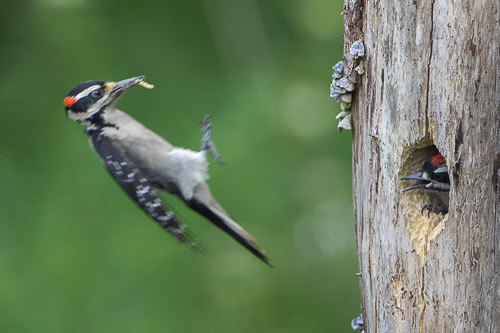
Keep in mind as well that the EVF image is a video feed, with a refresh rate that usually works unnoticeably, at 1/60 sec on my A7 III and a6300. But a bird at 40 mph moves a foot in 1/60 sec. You thought that merganser’s eye was in the middle of the frame but really it may be off to the left edge. Try shooting kinglets flitting from branch to branch in the forest. Speed of auto-focus aside, an optical viewfinder wins in these instances.
Finally there is the issue is auto-focus speed. Until recently, mirrorless relied on contrast detection focus. This was accurate but slow. dSLR’s relied mostly on phase-detection, fast and therefore the choice for sports and action.
All these mirrorless downsides are diminishing rapidly. Battery life and recording speed improve with each new camera. Autofocus with electronic shutter and no blackout compromise, first seen in the Sony A9, will work its way to more affordable cameras. The A9 and other recent mirrorless bodies fuse contrast with phase-detection for fast, accurate systems that rival or even beat dSLR auto-focus. And Sony has announced a 240 frame/sec viewfinder refresh rate. Mirrorless may soon be all upside.
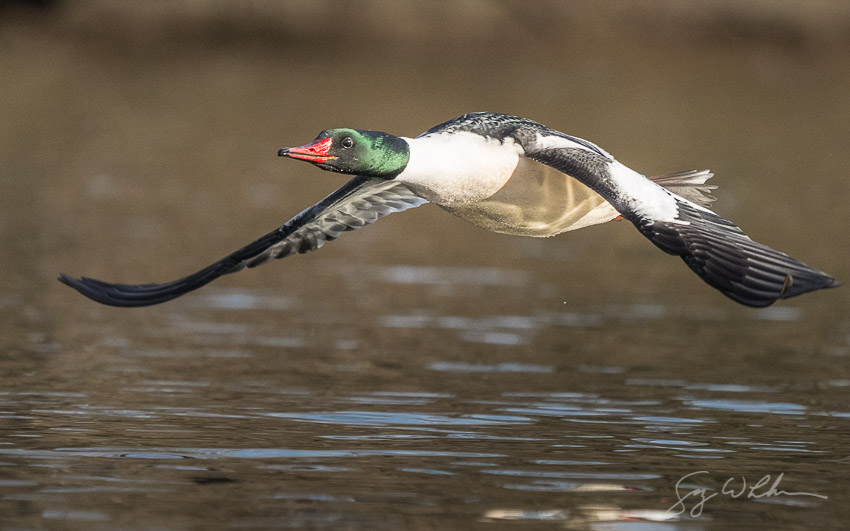
After an hour or so on the water I paddle back to the put-in, car-top the kayak and drive home. I’m pleased when I get a look at the fresh A7 III images in Lightroom. I once again have numerous keepers of challenging BIF.
Gary
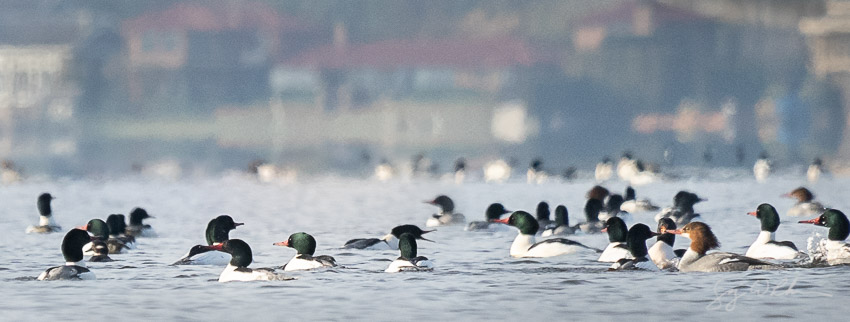
Looks good Gary. Thanks for your evaluation of the mirrorless approach. It was easy to understand and certainly tempts one to go in that direction.
Thanks, Robert. Right now, I can’t say that I’m getting better images than had I stuck with Canon, even though I like what I’m getting. But the future is mirrorless; less claptrap, more tech.
Great analysis and I appreciate the technical details comparing mirrorless and dslr technology. I love my Nikons but have my travel Sony RX10 Mark IV and I have to say the EVF is a little hard to get used to for me. Maybe the higher end mirrorless are a bit better. I agree that mirrorless is the future bit I still have to say the Nikon D850 is awesome!
You can’t go wrong with the Nikon D850. I don’t think the RX 10 IV EVF is dumbed down. I remember liking the view when I had the chance to look through it, but I didn’t try tracking moving subjects. And it is different; probably requires some getting used to.